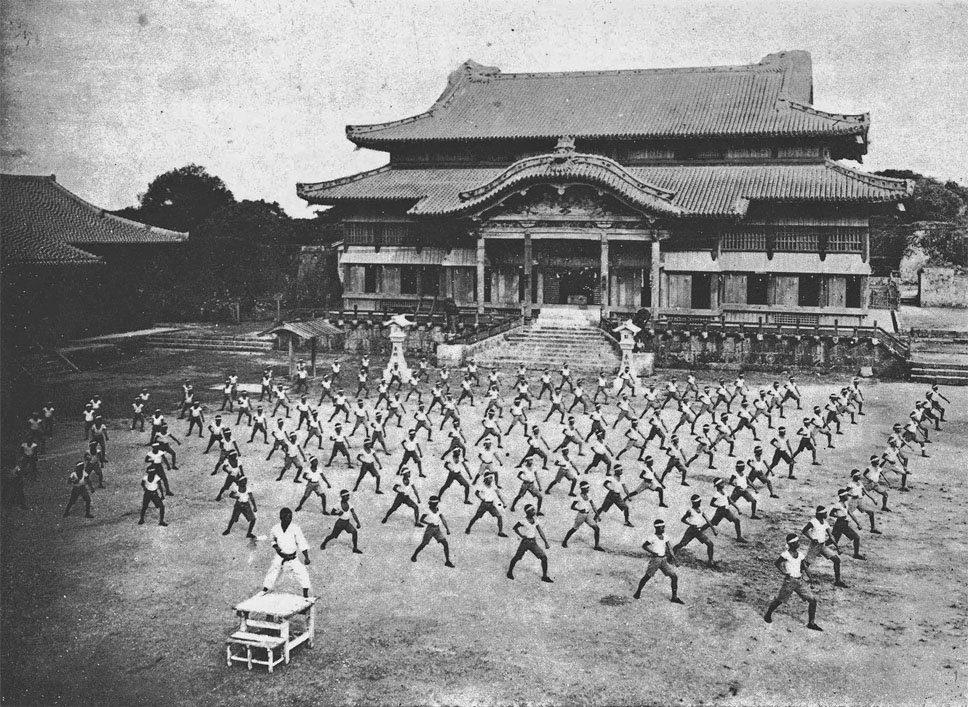The practice of Goju relates to the Goju ryu of Chojun Miyagi of Okinawa the foremost founder and Grand Master of this style of combative technology for the islands of Okinawa, the origin of the empty hand way or otherwise known as Karate-do.
The lineage of this particular style goes back to the earlier century from whence frequent trade between the Chinese and the Okinawans were often a setting for the exchange of social activities and cultural studies. The likes of what was then fighting methods and what was in fact a superior form of empty hand combat taught by the Chinese intrigued the Okinawan merchants and before long an import of what was to be an influence of the motivational kind – martial art, the feature of regimented training, and the art of which became an ideal, the empty hand way.
Having finally made its way to the Western shores of Hawaii in the early thirties, the island of Kauai became a launching pad for such a study. Master Miyagi unknown to many of his expertise, and what contained a formidable combative art that would popularize populations world wide will in fact feature in a modern day film called the ‘Karate Kid’.
On an invite by the local Okinawan migrants living on the island of Kauai that migrated to these islands for employment in the sugar fields and pineapple fields, hosting such a prominent person from their mother land was a promotional feat that would go on through history that will associate the reasons for local Hawaiian born children of migrant lineage becoming very versed in the martial arts and culture of their forefathers.
Many years later a young native born and raised from the island of Kauai would become a student of this infamous style his name, Constantino ‘Tino’ Ceberano under the tutelage of an Hawaiian born of Okinawan decent, Sensei Masaichi ‘Masa’ Oshiro, the first Goju teacher of authentic back ground as his father being an Okinawan was too an influence of this well known pioneer in his own rights of the Goju practice in the modern times.
This teacher saw promise and future in this eager local lad (Tino) which finally granted him a place in the teaching of the Goju style there in the island of Honolulu from the early year of 1962. It wasn’t long after having done extensive practice and personal internship to Oshiro sensei that young Tino Ceberano was given the go signal to migrate to Australia and commence teaching in this new country this art of ‘Goju’.
The pioneering spirit prevailed in this young instructor of Goju and have not since looked back on the progressive development that created a standard and setting for the present Martial Art reputation and prestigious standing that all stylists in Australia are proud of.
As in the days of the Miyagi Chojun early in the last century, taking it from his peers and his mentor the then master of the Okinawan China hand or Toudi, he too moved on to progressively educate the populace of the southern part of the island mainly Naha. He had been involved in the education department and was also a civil leader having had privileges to explore and expand his art. It traveled to Japan and to the university of Retsumeikan in the Western Sector of Japan’s main island Honshu where lies the former capitol city known as Kyoto.
A student in the University having been a practitioner of Martial Arts of many years, inherited from his father and family before him, was an avid follower and before long became the senior student and finally the head propagator of the Japan Goju Kai, Gogen ‘The Cat Yamaguchi’ was his name.
Coincidental as it may seem, Tino Ceberano has since followed the trait of his peers to what has now become his approach to research and study in this important feature of an activity that contains the science of training in all facets and how it is as a motivational influence to the society, that now more than ever, needs this form of training and its attributes.
Tino Ceberano presents this progressive study of Goju as a lead into the finer points in training, the science in clarifying what becomes of techniques, and the attributes of training along with other disciplines, enhancing the very nature of individual’s experience to locate and discover, the understanding of tactile study.
– Written by Hanshi Tino Ceberano 2011
